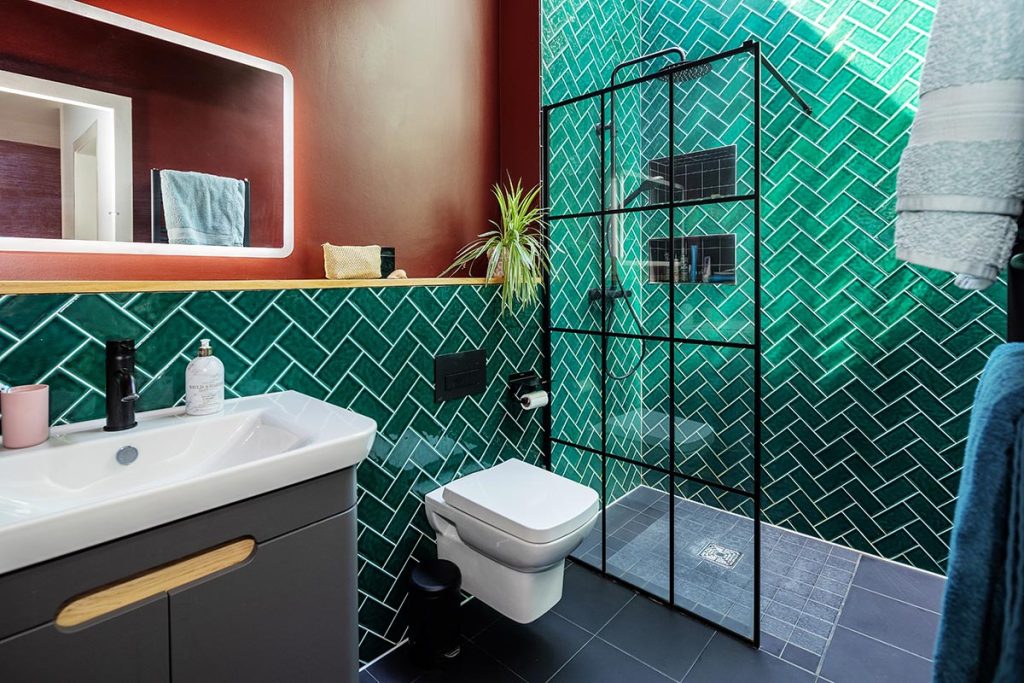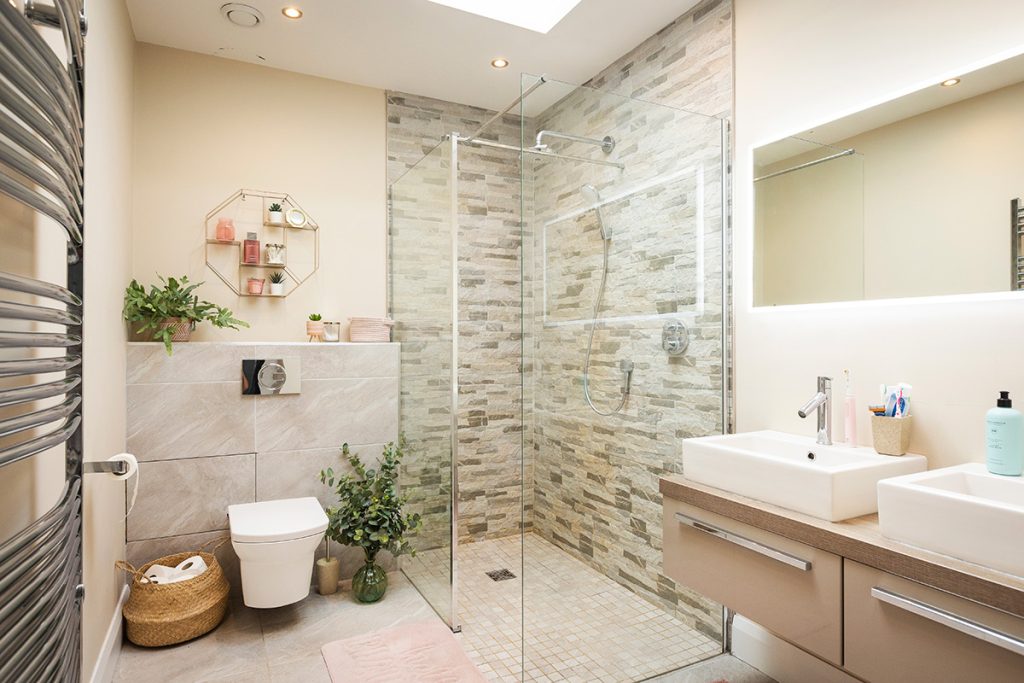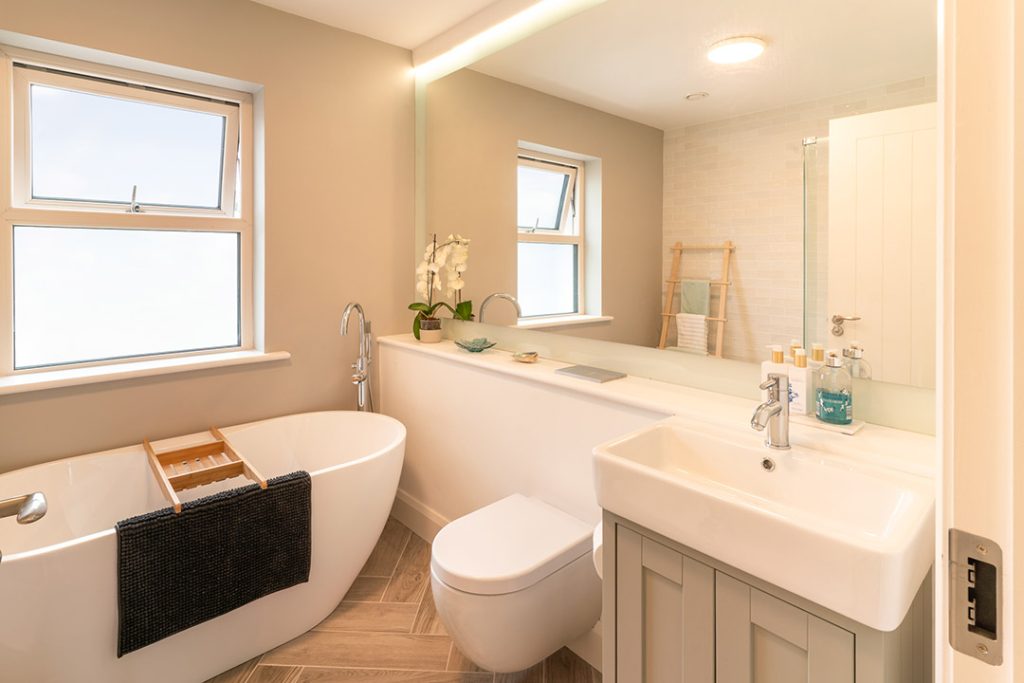When it comes to renovating your bathroom, it can be an exciting project that often gets overlooked or left to the end. This is particularly true in new builds. Too often, people rush to pick sanitaryware and tiles without giving it the thoughtful consideration it deserves. However, the bathroom provides a unique opportunity to create a luxurious sanctuary in your home. In this comprehensive guide, we’ll delve into the top 5 tips for bathroom design, including when to start planning, what to prioritise, and how to be budget-savvy. Let’s embark on a journey to transform your bathroom into a personal oasis.
Expressing Your Unique Style
Your bathroom is a canvas where you can let your creativity run wild. Unlike other rooms in your home, it doesn’t need to follow a particular theme or “flow.” It’s a private space where you can experiment with bold patterns and designs that might be too overwhelming in other areas of your house.

1. Play with Patterns and Wallpaper
Introducing wallpaper into your bathroom can infuse a touch of fun and personality. Opt for patterns that resonate with your style, and remember to apply a decorator’s varnish to seal the wallpaper properly. Wallpaper offers versatility, allowing you to update your bathroom’s look easily and affordably. Unlike tiles, which are more challenging to change, wallpaper provides a dynamic design choice.
2. Antique Chandeliers and Custom Fixtures
Don’t shy away from incorporating antique chandeliers, provided a registered electrician checks the fitting. Bespoke fixtures, like a glazed wall in a wetroom or a custom-made vanity unit, can add a touch of class and individuality to your bathroom. For those on a budget, consider fitting standard size units thoughtfully into your space, creating a stunning yet cost-effective solution. Planning ahead for such additions is key to their success.
Prioritising Maintenance and Practicality
While aesthetics play a significant role in bathroom design, it’s equally important to consider practicality and ease of maintenance.
3. Choose Sanitary Ware Wisely
When selecting your toilet (wc), think about ease of maintenance. Close-coupled toilets, where the pan and cistern are visible and on the floor, are often the least expensive but can be challenging to keep clean. The floor-mounted back-to-wall wc is a mid-range option, requiring a concealed cistern behind a stud wall. The wall-hung toilet, while the most expensive upfront, is the easiest to maintain and clean, as it’s mounted on a metal frame.

For tiles, stone may be pricier to fit and may need sealing before installation, a detail often overlooked by self-builders. Consider grout color carefully, as a darker shade may hide stains and wear better in the long run. When choosing shower tiles, remember that smaller tiles require more grout, which translates to more cleaning. Specify the thickness of grout lines based on your maintenance preferences.
4. Embrace Smart Bathroom Technology
Integrating technology into your bathroom doesn’t have to break the bank. Motion sensors (Passive InfraRed or PIR) are a cost-effective addition, allowing you to control ambient lighting in window-less bathrooms or activate shower area lights. Plan your lighting circuits thoughtfully to avoid unnecessary noise from the fan.
Consider an electric towel radiator with a mains connection, allowing you to use it even when the heating isn’t on. Ensure it’s programmable and thermostatic for convenience and energy efficiency. Demister pads, positioned behind mirrors, provide a fog-free surface for shaving or makeup application after showering. Electric underfloor heating, while an initial investment, offers comfort and cost-effective heating for short periods.

Efficient Storage Solutions
5. Strategise Your Storage
A well-organised bathroom is a pleasure to use. When planning your storage, consider open shelving only if you’re committed to keeping it clutter-free. Messy items on display can detract from the overall aesthetics. Explore every stud wall as a storage opportunity. Create alcove-shelf recesses within shower walls, with a slight incline toward the front to prevent water accumulation.
Think about your specific storage needs, from towels to toiletries, and plan accordingly. Each inch of space can be utilised creatively to optimise storage and maintain a tidy bathroom.
The Importance of Careful Planning
The success of your bathroom redesign hinges on meticulous planning. Every aspect of the project requires coordination, from selecting sanitary ware and tiles to the timing of tradespeople. Here’s why planning is crucial:

6. Coordinated Efforts
In a small space like the bathroom, every trade must work together seamlessly. This includes general labor, plumbers, electricians, carpenters/joiners, plasterers, tilers, and decorators. Ensure that sanitary ware and tiles are not only chosen but on-site before work commences to prevent delays.
7. Avoiding Costly Surprises
Labor costs and timelines can vary significantly based on your fittings and fixtures. Builders often provide competitive quotes assuming straightforward installations. Deviating from these assumptions can lead to extra expenses and potential strain on your relationship with the builder.

8. Timely Delivery
Keep in mind that some tiles and sanitary ware items may have lead times. Having these items ready on-site before work begins ensures a smooth workflow and minimizes delays. Be clear about responsibilities for demolition and debris removal to maintain a tidy work environment.
By following these top 8 tips and meticulously planning every aspect of your bathroom redesign, you’ll transform this space into a luxurious, functional, and visually stunning retreat. Embrace your unique style, prioritise maintenance, and utilise efficient storage solutions to create a bathroom that truly reflects your personality and meets your practical needs. With careful planning and attention to detail, your dream bathroom is well within reach.




